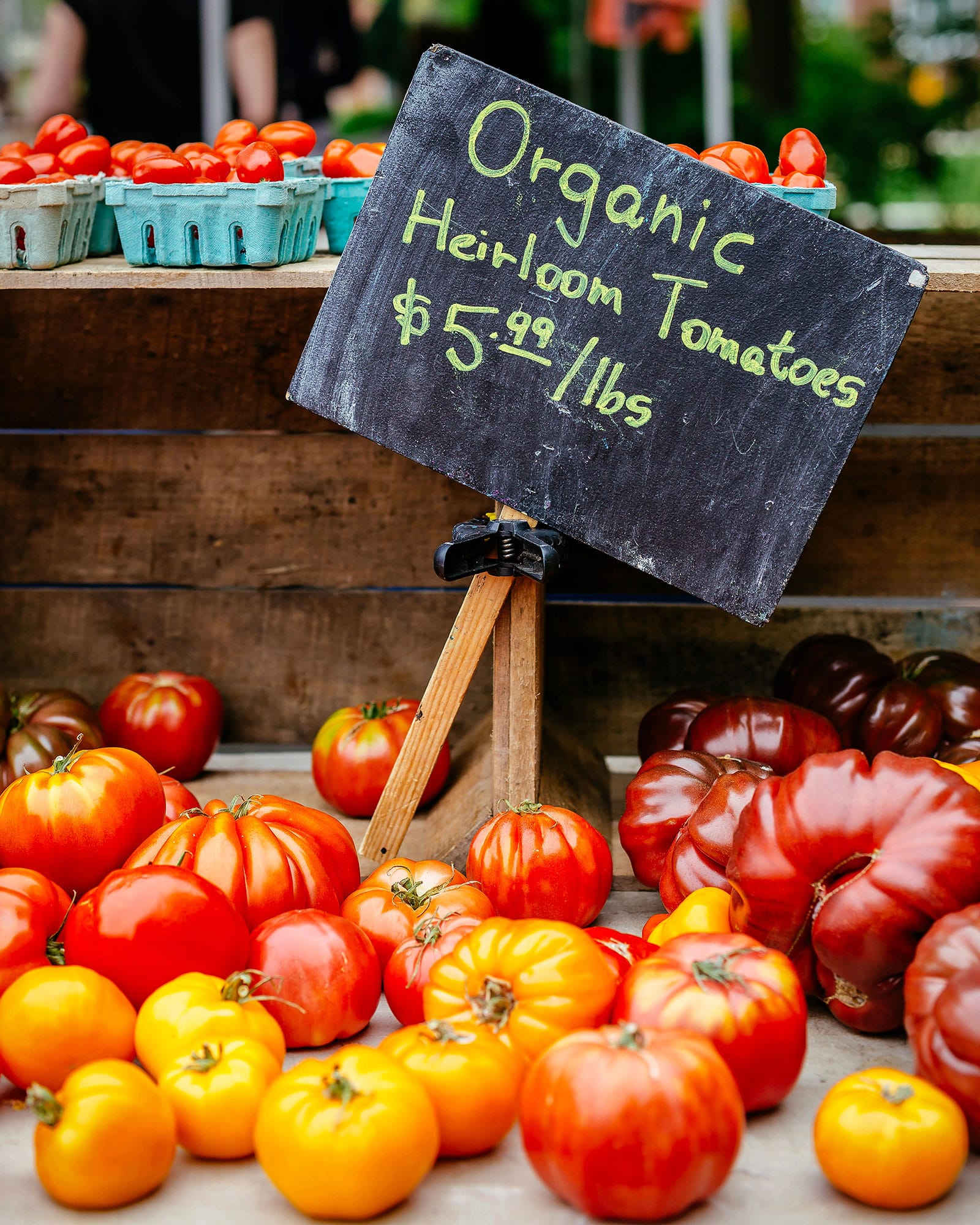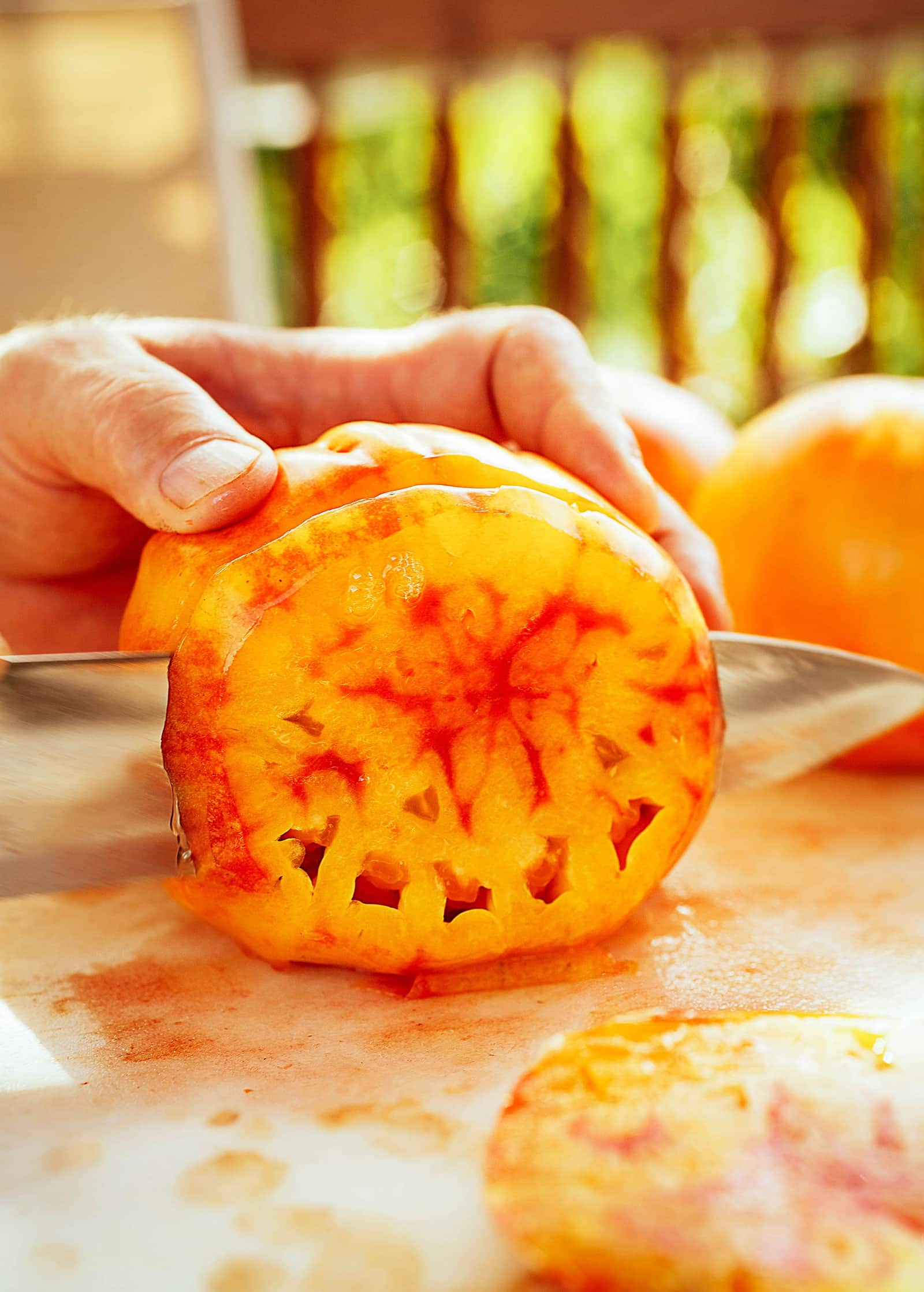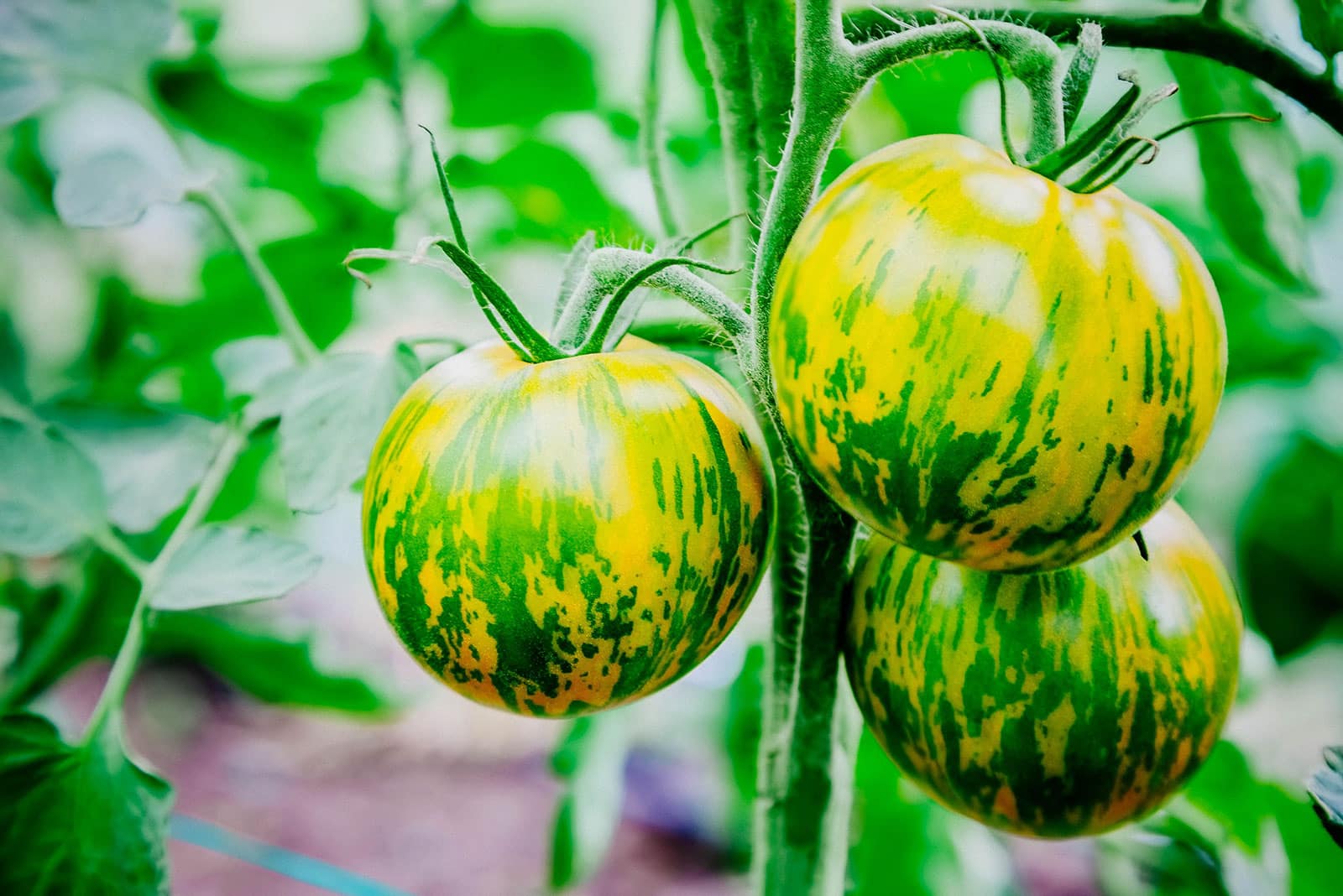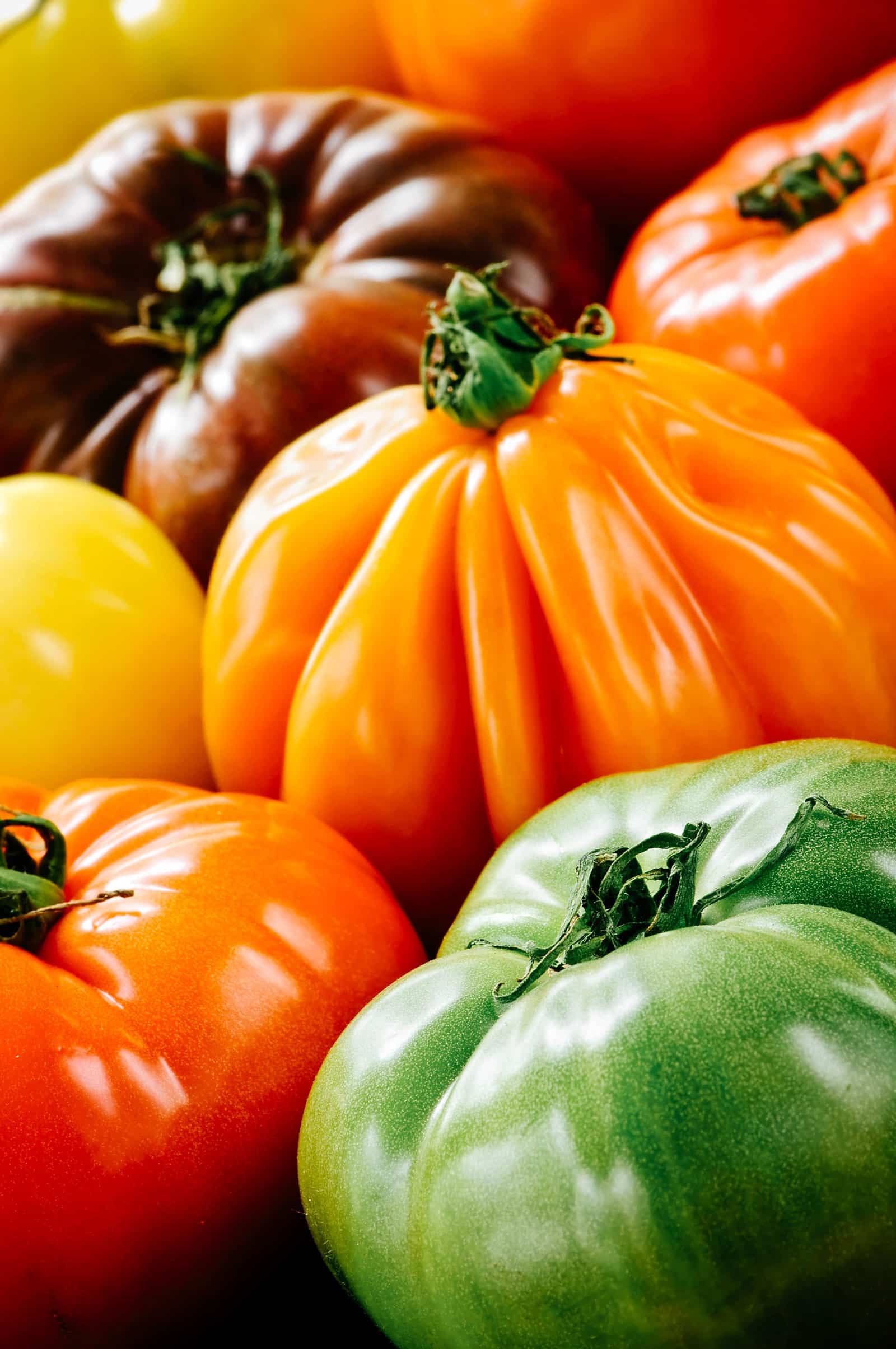Tired of bland, watery tomatoes? Yeah, me too.
That’s why, like many folks in recent years, I got into buying and growing heirloom tomatoes. These colorful, strangely shaped orbs may not have the same shelf life or pretty, even shape and color, but they pack a flavor punch that no supermarket water bomb can compete with.
There are thousands of heirloom tomato varieties, and I’m not going to lie and say I’ve managed to try them all.
I have, however, sampled enough to be able to put together a list of the best tasting tomatoes. (Some of these varieties are also consistent winners in annual tomato festivals and tasting events.)
Let’s have a look at what all the heirloom tomato fuss is about and which ones you should put on your shopping list!
Disclosure: If you shop from my article or make a purchase through one of my links, I may receive commissions on some of the products I recommend.

What is an heirloom tomato?
Most gardeners are somewhat familiar with the concept of heirloom tomatoes: colorful, amazing flavor and often strangely shaped, with a softer skin than that of a “supermarket” tomato.
But what makes a tomato an heirloom tomato?
There’s no set definition, but at the very least, an heirloom tomato needs to be open-pollinated and non-hybrid.
That first term means that they breed true (that is, the offspring is the same as the mother plant) and that they can be pollinated naturally, like by bees or the wind. There is no need to carefully select the two parent plants.
Read more: How to decipher what all those abbreviations mean in your seed catalogs
“Non-hybrid” refers to a plant that hasn’t been cross-bred, genetically modified, or subject to any of the sometimes funky growing practices that are involved with producing a perfectly red and round supermarket tomato.
It’ll usually be less disease-resistant, but that shouldn’t be too much of an issue if you’re just growing a plant or two at home.
Lastly, the heirloom aspect itself comes from the fact that in many instances, these tomatoes really were (or still are!) family heirlooms. Some have been around since the 1800s, with families carefully saving and passing on the seeds of the tastiest tomatoes that popped up in their gardens.
Related: The histories behind heirloom seeds are what make them so special

Why do heirloom tomatoes taste better?
Biting into a lovingly cultivated heirloom tomato picked at exactly the right time can be a rather intoxicating experience.
Is this what a tomato is supposed to taste like? And more importantly, why don’t they all taste like this?
The answer is the same for many of the vegetables and fruits found in supermarkets nowadays. They’re bred for thick, shiny skin and pretty, uniform appearance, not for flavor.
They need to hold up after being picked unripe and then shipped halfway across the planet, and they need to have nice color and shine so consumers will be attracted to them.
This unfortunate process of swapping flavor for appearance has been confirmed scientifically. One big 2017 study analyzed a whopping 398 tomato varieties and concluded that modern fruits do indeed lack the genetic ability to produce various important flavor compounds.
Modern cultivars boast a combination of genetic alleles that improves size and other commercially important characteristics like color, for example, but that also decreases their sugar production. Whoops!
(This, among several other research-backed reasons, is why you should always try to grow your own food.)
Many other researchers have come to similar conclusions. One group noted that a gene that promotes uniform softening unfortunately also affects a tomato’s ability to produce sugar. The same goes for uniform ripening in terms of color, which is what got rid of the green shoulders visible on a lot of older tomatoes.
The good news? Authors agree that it should be possible to add flavor back to our tomatoes. Until then, however, I’ll stick with my big, ugly, soft-skinned but divinely tomato-ey heirlooms, thank you very much.
Did you know?
Other factors that negatively influence tomato flavor are involved after they’re picked. One big one is that underripe tomatoes are often refrigerated, which makes them keep longer but unfortunately also makes them taste worse.
What defines tomato flavor?
So what actually makes a tomato taste good (or not good, in the case of those supermarket tomatoes)?
There’s a lot involved, including a whole bunch of volatile compounds identified by the authors mentioned in the previous section. These burst into the air as we cut or bite into a tomato, doing their magic on the olfactory (nose) part of how we perceive flavor.
Learn more: All tomato leaves have this distinctive smell, and this is why
Other than this, I already mentioned one of the main players: sugar. The sugars in a tomato are mostly fructose and glucose, making up around 50 percent of its dry matter.
The other important factor in tomato flavor is acid (mostly citric and malic, which are pretty standard in a vegetable).
The more sugar and acid a tomato contains, the better ratings its flavor tends to get, although of course everyone has their own personal preferences. Some like low acid and high sugar, for example, while others consider it bland!
This being said, most folks agree that low acid and low sugar tomatoes are the worst.
Did you know?
Sugar production in a tomato is strongly associated with light. The presence of acid is mostly associated with potassium in the soil.

The Brix scale
Since sugar is so important for tomato flavor, being able to measure it is pretty handy. And we can!
Brewers, wine makers, and honey producers use something called the Brix scale, which has been around for almost 200 years and indicates the sugar content in a solution.
By using a refractometer, the sucrose content in a few drops of tomato juice can easily be established. The higher the °Brix, the more sugary your tomato, and the better the flavor is likely to be.
Did you know?
One of the sweetest tomatoes in the world—an heirloom variety called Prairie Fire—rates 10 out of 10 on the Brix scale! It’s also an excellent short-season tomato to grow at home, as it matures in only 65 days.)

The relationship between color and flavor
Although we’ve just learned that there’s a lot that goes into making a tomato taste good, there are actually some things you can glean by looking at one. Although this is by no means an exact science, tomato color does tend to reveal a little of what you can expect!
The general rule of thumb is:
- Red and black tomatoes are more acidic, so they tend to taste vibrant and tart.
- Pink tomatoes are a little less acidic, so they can be considered red and black’s milder cousins.
- Orange tomatoes are usually quite low on the acid scale.
- The same goes for yellows, which are also generally pretty mellow in flavor.
- The greens (and I mean green-when-ripe varieties, not unripe green tomatoes) may look like they’ll be tart, but are actually generally very sweet and bright.
- White and striped tomatoes are often the sweetest, boasting an almost fruity flavor.
This doesn’t always mean a certain tomato type will taste the same year to year, however. Environmental factors like heat and water stress can affect flavor too.
And no matter what color your tomatoes are, it’s important that they be fully ripe so they’re at peak quality. (Here’s a guide to help you figure out when to harvest tomatoes for the best flavor and texture.)

My picks for great-tasting heirloom tomatoes
Red
- Stupice: A small to medium, early and weather-tolerant variety from Czechoslovakia with great flavor and fantastic production.
- Chadwick Cherry: First created by the late and great tomato guru Alan Chadwick, these little cherries grow on huge plants. They’re very productive and taste wonderfully sweet.
- Amish Paste: There are many heirloom plum tomatoes that have become crowd favorites, like Roma and San Marzano, but Amish Paste may just be “the one.” Perfect for a delicious homemade tomato sauce.
- Thessaloniki: Named after a city in its home country of Greece, this one’s medium-sized, beautifully red and shiny, and perfectly round. Although it looks might be that of a supermarket tom, its flavor is a balanced mix of sweet and tart.
- Italian Heirloom: This robust, slightly ribbed beefsteak tomato (up to a pound!) is a great all-rounder and a long-time favorite for both sandwiches and sauces.
Pink
- Brandywine: One of the most famous heirlooms, this one even has its own Wikipedia page. It’s a bit slow to mature and not all that prolific, but it just tastes absolutely divine.
- Pink German: Another big one, Pink German is one of the founding varieties for the well-known Seed Savers Exchange, which is dedicated to saving and distributing heirloom seeds. Very sweet and versatile.
- Caspian Pink: Originally from Russia, this one produces flattened tomatoes that consistently get great flavor ratings. One slice covers an entire sandwich!
Yellow
- Yellow Pear: These little pear-shaped yellow cherry tomatoes have a special place in my heart. They’re mild and slightly citrusy. I love them in a big cherry tomato salad, especially with a nice ball of burrata cheese. (It’s also my kids’ favorite to eat right off the vine!)
- Azoychka: Another very pretty yellow heirloom, this one’s on the larger side. It’s a prolific Seed Savers Exchange classic (this time from Russia) and wonderfully mild and tart in flavor.
- Blondkopfchen: Its name means something like ‘little blonde’’ in German, and that does seem appropriate. Huge vines chock-full of tiny orange-yellow cherry tomatoes; good luck trying not to eat them all straight from the vine!
Green
- Green Zebra: One of the prettier heirloom tomatoes, Green Zebra is small to medium in size and sports horizontal green stripes on a yellowish base. It hasn’t been around for that long, but its looks and rich flavor have made it an instant classic.
- Cherokee Green: Big, green to yellow and packed with lightly tart tomato flavor, this one was first grown by Craig LeHouillier, a bit of a celebrity in the world of heirloom tomatoes.
- Green Giant: Beautifully deep green in color, Green Giant—as the name suggests—does indeed get very large. The flavor and texture are fantastic and the plants are easy to grow and maintain.
- Aunt Ruby’s German Green: Another rather humongous green beefsteak, this prize-winner has that perfect tart to almost spicy green tomato flavor. A dose of sweetness balances it all out!
Black
- Cherokee Purple: Yep, there’s more than one Cherokee tomato variety! In fact, this is the original one. It’s thought to have been around since the late 1800s, although it took the world by storm in the 1990s thanks to distribution by Mr. LeHouillier. Hands down, this is my absolute favorite tomato variety and one I grow every year. To me, it has a rich, deep sweetness with a hint of umami.
- Black Krim: Pretty much the first of the “black” tomatoes to take hold in the US, Black Krim is originally from Crimea. It’s large, slightly flat, red with a dark green to purplish hue and absolutely delicious. Another go-to in my garden!
- Paul Robeson: Here’s another prize winner with beautiful color and amazing flavor. Despite being from Russia, it was named after a Black American performer and activist.
- Carbon: Dark-colored tomatoes are associated with deep flavor, and Carbon definitely doesn’t disappoint in this department. It’s described as sweet and almost smoky, and it’s very pretty to boot.
- Black Beauty: Despite falling in the “black” tomato category, the aforementioned varieties are more of a regular red with some dark green on the shoulders. This one is a different story… it can truly be deep purple to black. The flesh is dark red and tastes fantastic. Black Beauty really does have it all!
- Black Cherry: The darkest of the heirloom cherry tomatoes, this is another fantastic choice if you like prolific plants that abundantly produce yummy, smoky-tasting fruits. I grow this variety almost every year.
Orange
- Ruby Gold: What a beauty! I wasn’t even sure whether to put Ruby Gold in the “yellow” or “orange” category, as it tends to have a yellow base with reddish to orange marbling. Also sometimes known as Gold Medal, it definitely deserves one for its superb flavor.
- Kellogg’s Breakfast: Another classic in the world of heirloom tomatoes, the pretty orange Kellogg’s Breakfast is large, bright orange and delightfully sweet.
- Jubilee: This perfectly golden variety has been around since the 1940s and still holds up just as well today. It’s sweet and mellow, with the huge plants producing vigorously throughout summer.
- Persimmon: Yep, if you kind of squint, you really could confuse this tomato for a beautiful bright orange persimmon fruit. This big beefsteak variety is creamy, mildly sweet and fleshy, with few seeds.
- Jaune Flamme: If all of these massive orange slicer tomatoes are a bit too big for your taste, maybe you’ll like this French heirloom beauty. Its name means “yellow flame,” and although the fruits don’t tend to surpass 5 ounces, the variety is huge in flavor.
- Big Rainbow: Here’s another very decorative yellow-and-red striped beefsteak tomato that can weigh up to 2 pounds. One of Seed Savers Exchange’s success stories, it’s supremely juicy and offers big yields.
- Pineapple: How pretty is this yellow-and-red marbled slicer? Toast, mayo, and a slice of ‘Pineapple’ is what summer picnic dreams are made of. And it has few seeds, so more tomato goodness to go around!
White
- White Beauty: This pale yellow beefsteak is known for its low acidity and exceptional creaminess. The taste is even described as slightly citrusy.
- Great White: Another big slicer, this one is described as having a fruity flavor, making it perfect for eating as-is, in a sandwich or in a nice chopped salad. Very low acid levels.
where to buy seeds
Sources
- Kleinhenz, M. D., & Bumgarner, N. R. (2012). Using Brix as an indicator of vegetable quality. Linking measured values to crop management. Fact Sheet. Agriculture and Natural Resources. The Ohio State University, Columbus, OH.
- Petro‐Turza, M. (1986). Flavor of tomato and tomato products. Food Reviews International, 2(3), 309-351.
- Powell, A. L., Nguyen, C. V., Hill, T., Cheng, K. L., Figueroa-Balderas, R., Aktas, H., … & Bennett, A. B. (2012). Uniform ripening encodes a Golden 2-like transcription factor regulating tomato fruit chloroplast development. Science, 336(6089), 1711-1715.
- Tieman, D., Zhu, G., Resende Jr, M. F., Lin, T., Nguyen, C., Bies, D., … & Klee, H. (2017). A chemical genetic roadmap to improved tomato flavor. Science, 355(6323), 391-394.
- Uluisik, S., Chapman, N. H., Smith, R., Poole, M., Adams, G., Gillis, R. B., … & Seymour, G. B. (2016). Genetic improvement of tomato by targeted control of fruit softening. Nature biotechnology, 34(9), 950-952.
More tomato growing posts to explore:
- Grow Tomatoes Like a Boss With These 10 Easy Tips
- How to Grow Tomatoes in Pots—Even Without a Garden
- How to Best Fertilize Tomatoes for the Ultimate Bumper Crop
- How to Repot Tomato Seedlings for Bigger and Better Plants
- Why and How to Transplant Tomatoes (a Second Time)
- Planting Tomatoes Sideways: How Growing in a Trench Results In Bigger Healthier Plants
- Florida Weave: A Better Way to Trellis Tomatoes
- Conquer Blossom End Rot and Save the Harvest
- Can You Eat Tomato Leaves? The Answer Will Surprise You
- Why Tomato Leaves Have That Unique Smell
- The Power of Fermenting and Saving Tomato Seeds
- 4 Fastest Ways to Ripen Tomatoes in the Garden and Beat the First Frost
- The 30 Best Tasting Heirloom Tomato Varieties (By Color!)
- 83 Fast-Growing Short-Season Tomato Varieties for Cold Climates
- The Best Time to Pick Tomatoes for Peak Quality (It’s Not What You Think!)
















Ive grown Cherokee Purple, black beauty, and some others. Here in Montana. The tadte is absolutely amazing
The only tomato listed here that grows well for me and tastes great is Black Cherry. The rest, and I’ve grown quite a few of these, are bland, disease prone, or get overrun with pests. I think that your climate, your pests and diseases, and your soil will have a tremendous impact on how well you do with any tomato variety. I don’t doubt that the author had a good experience with the tomatoes listed, but you might have a completely different experience where you live. I would list the tomatoes I like, but you woul need to live in the IS in zone 6A and have similar soil and gardening practices to have the same results. So experiment with as many tomato varieties as you can and have room for each year and you will find a number of great heirloom tomatoes that you can grow well and will appeal to your sensibilities.
very well written article. lots of good instruction, ideas, and hopes for great tomatoes